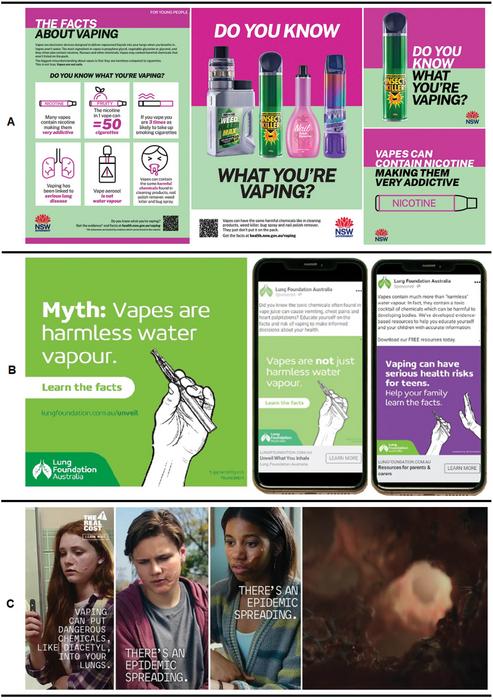Flinders University researchers say that cohesive and collaborative action from preventive health communicators and organisations is needed to inform young people about the devastating harms of vaping.

Credit: Health Promotion International -https://academic.oup.com/heapro
Flinders University researchers say that cohesive and collaborative action from preventive health communicators and organisations is needed to inform young people about the devastating harms of vaping.
“Despite awareness of the potential harms, recreational vaping is increasing among younger people with our South Australian participants seeing vaping as ‘cleaner’ and less harmful than cigarettes,” says Flinders University’s Dr Joshua Trigg.
“We know that nicotine vapes are highly addictive and expose people to harmful chemicals, respiratory irritants, and toxic substances. In order to discourage young people from picking up a vape, we need to understand what messaging they will best respond to,” says Dr Trigg.
Vapes, or e-cigarettes, are lithium battery-powered devices that heat liquids containing solvents, nicotine, flavourings and other chemicals, volatile compounds, and ultrafine particles into an aerosol that are inhaled into the lungs.
Flinders University researchers investigated the impact of different vaping prevention public health media campaigns among young South Australians aged 16–26 years to help determine what will work best in vaping risk messaging.
Participants of the study were shown example materials from three vaping prevention campaigns and resource sets: ‘The Real Cost, ‘Do you know what you’re vaping’ and ‘Unveil what you inhale’ to assess whether they were easily understood, appropriate, relevant, credible and effective.
“We know that health communication campaigns are an established tool for emphasising the dangers associated with vaping. By studying the impact of these campaigns more closely, we can improve future messaging to reduce and deter the use of vapes by young people,” he says.
Those who do vape and those who don’t, reacted in different ways to the campaigns. Those who didn’t already vape responded better to explicit messaging and shock tactics about the health risks associated with vaping. Whereas those who already vaped responded better to information challenging the notion that vapes are healthier than smoking cigarettes.
“We found that young people are likely to engage more with campaigns that consider the real life experiences, social contexts, and negative consequences associated with vaping. These experiences drew more interest and were more thought provoking to young South Australians,” Dr Trigg says.
“Bright visual design elements that represented health and wellbeing drew the attention of both groups of young people, with participants reiterating the benefits of using online and media resources to deliver preventative media campaigns. Campaigns now tend to adopt a ‘mobile first’ design approach, to target their audiences where they consume media” he says.
“In future, it is important that vaping prevention messaging considers those who already vape and those who do not, and clearly address the potential dangers and side-effects of inhaling a combination of chemicals. Young people need to understand that nicotine vaping is not a risk-free alternative to smoking cigarettes,” he adds.
The research – “Vaping harms awareness messaging: exploring young South Australians’ responses to vaping prevention campaign materials”, by Joshua Trigg, Ola Ela, Jacqueline Bowden, Ashlea Bartram, Clinton Cenko, and Billie Bonevski – has been published in the journal Health Promotional International. https://doi.org/10.1093/heapro/daad145
Journal
Health Promotion International
DOI
10.1093/heapro/daad145
Method of Research
Survey
Subject of Research
People
Article Title
Vaping harms awareness messaging: exploring young South Australians’ responses to vaping prevention campaign materials
Article Publication Date
11-Nov-2023




